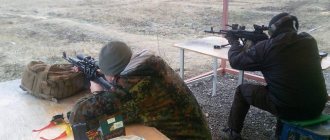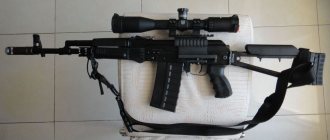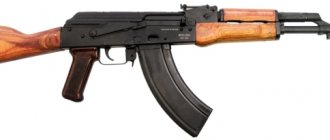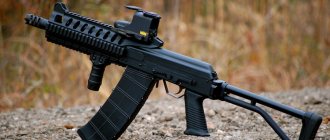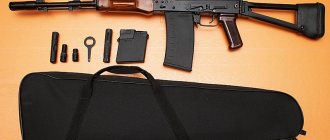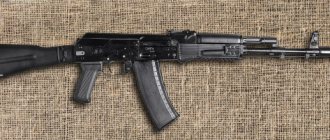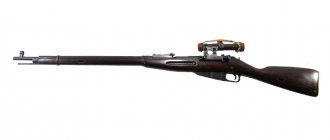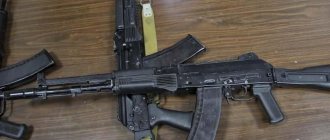History of creation
The country's leadership set a task for gunsmiths to create a new hunting carbine and test it in the Kazakh steppes. The first prototype of the Saiga self-loading carbine appeared four years after its development began.
In 1974, after testing the prototype, the Saiga 5.6 rifled carbine chambered for 5.6x39 mm went into mass production. However, the industrial production of a version of the Kalashnikov assault rifle chambered for a hunting cartridge did not make this weapon available to Soviet citizens.
The Wild Nineties gave the Saiga carbine line a new lease of life.
was experiencing big problems with government orders at that time. Rampant crime has significantly increased the demand for civilian versions of the AK. The population massively purchased smooth-bore self-loading carbines for self-defense, which was the reason to revive the serial production of Saiga on the Izhmash weapons lines.
A version of the smoothbore shotgun chambered for the .410 Magnum cartridge was launched into production. The Saiga-410 carbine was suitable for self-defense, sports or training shooting, and hunting small animals. At that time, the .410 Magnum cartridge was rare in the circulation of hunting equipment in Russia, as it was mainly supplied from abroad.
However, the demand for new weapons also entailed the organization of their production at domestic cartridge factories.
Inspired by demand, IZHMASH designers began to develop a smooth-bore Saiga, based on the same AK, for the use of 20-caliber cartridges. This type of carbine was suitable for hunting medium-sized animals and had prospects for taking a strong place in the security business.
At the end of the 1990s era, the most effective prototype of the family appeared - the Saiga 12 smoothbore carbine, which showed the best technical characteristics in terms of firing range and had impressive power.
This weapon has become popular not only in the civilian market, but also by law enforcement officers. The Saiga-12K combat carbine is specially produced for special forces soldiers under the designation “18.5 KS-K” (Special Carbine - Kalashnikov).
In addition, a line of rifled weapons was developed based on the AK. This is a Saiga-M self-loading carbine, but unlike the smooth-bore variants, the Saiga-M barrels were rifled. The rifled Saiga, like the smoothbore one, was produced in several common calibers. So in the early 2000s, a version chambered for the .223 Remington cartridge was released, called the Saiga 223 (MK) carbine.
Rifled carbines were produced in various designs, but the versions that imitated the combat versions of the Kalashnikov assault rifle were in greatest demand.
This range of weapons was represented by the following versions of weapons:
- M - version of the carbine is equipped with an extended barrel of 555 mm, for caliber 7.62x39 and .223Rem;
- MK - the model is equipped with a short barrel in two versions: 336 mm/415 mm;
- M1 – version of the carbine with a quick-release stock and fore-end;
- M2 – carbine with an orthopedic wooden butt with a rubber shoulder rest and a rubberized forend;
- M3 – model with a folding stock and a function for adjusting the shoulder rest;
- M "Praktika" - the carbine has a folding adjustable stock and is equipped with a Picatinny rail for mounting unified sights and a guide neck for instant magazine change.
Saiga-12: Kalashnikov for cops
Technology proven over the years, a wide range of models, versatility, relatively low price... These are just some of the secrets of the popularity of one of the most successful models of domestic civilian weapons - the Saiga-12 carbine, produced by the Kalashnikov concern.
Russian weapons are valued all over the world - this is common knowledge. Even highly developed and very technologically advanced countries, such as the USA, are willing to buy it. More recently, in 2012, the American police purchased large quantities of Russian Saiga-12 smooth-bore semi-automatic magazine-fed rifles for their units.
The main requirements of Americans when purchasing weapons were the reliability and power of guns. And the products of the Kalashnikov concern (formerly NPO Izhmash) fully met their expectations. Which is logical, because thanks to the semi-automatic reloading mode, quick changeover and large magazine capacity, the Saiga-12 is truly the most optimal weapon for ensuring law and order in urban environments.
The Saiga hunting carbine was created at the Izhevsk Machine-Building Plant in 1974 on the basis of the Kalashnikov assault rifle. At first, the carbine barrel was rifled and made in 5.6x39 caliber (hence the name of the first models - “Saiga-5.6”).
In the early 90s, after the advent of carbines with 7.62 caliber cartridges (used in military weapons, “like the Kalash”), the popularity of the gun began to grow rapidly. So much so that the plant’s specialists decided to expand the model range. In addition to rifled guns, the production of smooth-bore guns was launched in Izhevsk in 1993. We have developed models for even more powerful 20-gauge Magnum cartridges.
Over time, a huge variety of modifications of the Saiga carbine appeared - with different barrel lengths, different calibers, cartridges, types of stocks and sighting devices, and various design options. But the most popular semi-automatic shotgun of domestic production was (and still is) the Saiga-12 carbine, developed in the second half of the 90s for the most universal and therefore most popular cartridge for 12-gauge smoothbore weapons.
The automation, design and layout of this weapon are similar to the Kalashnikov assault rifle. There are only two fundamental differences - the lack of the ability to fire in bursts and the presence of a gas regulator. The first drawback is easily overcome: you just need to press the trigger again. The second is generally more of an advantage, since it allows you to use both 12/70 and more powerful 12/76 cartridges, and also not worry too much about cleaning the weapon - and that’s how it works.
In addition to open sights, the Saiga-12 is equipped with dovetail or Picatinny rails. This significantly expands the capabilities of the weapon, as it allows the use of many additional devices: from under-barrel flashlights and laser designators to collimator and night sights.
The same variety is offered in terms of shops. For Saiga-12, they can have a capacity of 2, 5, 8, 10 or more rounds, up to large disc ones. Domestic magazines are single-row, loaded with cartridges in the same way as Kalashnikov assault rifle magazines. All Saiga-12 models can use 12/70 cartridges and reinforced 12/76 Magnum cartridges with any loads.
Saiga-12, in turn, also became the base model for a wide range of modifications. Let's list just a few:
– “Saiga-12S”, which has a folding stock (hence the “C” marking);
– “Saiga 12K”, which, in addition to a folding stock, also has a shorter barrel (hence the “K” marking). According to Russian laws, such models can only fire with a total length of more than 810 mm, so the gun is equipped with a blocker, and to use it, you need to fold back the butt (unfold it into the firing position). A shooter armed with a carbine with a short barrel becomes more mobile. In addition, a short barrel gives greater dispersion of shot or buckshot and increases the likelihood of a hit. Therefore, Saiga-12K is the most suitable option for self-defense and premises security;
– “Saiga-12C EXP-01” (export version), which also has a shorter barrel, but is not equipped with a lock (that is, this model can be fired with the butt folded);
– “Saiga-12S version 031”, considered a service weapon and also called KS-18.5 (service carbine, caliber 18.5 mm);
– “Saiga-12S Tactics”, characterized by a long sighting line, which ensures more accurate shooting of bullets;
– foreign modifications of Saiga-12, characterized by increased tuning. They are equipped, for example, with an orthopedic buttstock with an adjustable cheekpiece, a collimator sight and a laser designator. Or a folding frame stock, an original muzzle brake-compensator, a ventilated forend, and most importantly, a capacious disk magazine. A carbine modified in this way becomes most effective when firing buckshot indoors (for combat use when clearing buildings).
As a result, the Saiga-12, created on the basis of the Kalashnikov assault rifle as a hunting shotgun, nevertheless acquired its main fame as a self-defense weapon. There is an opinion that hunters are not particularly fond of weapons cloned from military weapons. But police officers, employees of special services and security companies, as well as athletes often prefer this particular carbine to all other options for smoothbore shotguns.
Design and performance characteristics
As already mentioned, the Saiga carbine is based on the basic version of the Kalashnikov assault rifle. However, the design has undergone a number of changes. First of all, the fire safety switch and trigger were changed. Saiga carbines have lost the ability to fire automatically. As is quite expected, the barrel itself has also changed, although the changes mainly affected variants for hunting cartridges.
The characteristics of the 7.62x39 mm barrel have remained virtually unchanged. It is worth noting that some models, especially export versions, received a shutter delay, for which this was done, I’m afraid not a single hunter will be able to explain.
In variants equipped with a folding stock, the possibility of firing with the stock folded has been blocked.
In addition, the magazine latch and the magazines themselves were redesigned, since the Federal Law “On Weapons” has a limit on the magazine capacity of civilian and hunting weapons.
The receiver of the Saiga carbine is somewhat different from the receiver of combat assault rifles, this primarily concerns the marks. Location of pins and stampings. In addition, it should be noted that, unlike linear AKs, all carbines are initially equipped with dovetail rails for installing optical and night sights. This is true for both smooth-bore and rifled versions.
Performance characteristics
| Modification | Saiga-410/S/K | Saiga-12/S/K | Saiga-20/S/K |
| Caliber | .410/.410/.410/ | 12/12/12 | 20/20/20 |
| Weight of the carbine without cartridges, kg | 3,4/3,4/3,2 | 3,6/3,6/3,5 | 3,5/3,5/3,2 |
| Practical length, mm | 1170/1080/840 | 1145/1060/910 | 1135/1050/910 |
| Length with stock folded, mm | — /840/595 | — /820/670 | — /810/670 |
| Barrel length, mm | 570/570/330 | 580/580/430 | 570/570/430 |
It is prohibited to use magazines from the combat version of the AK on the Saiga carbine. But, despite this, craftsmen and weapons tuning companies can work on using 30 local magazines in hunting weapons; it is worth noting that the magazine capacity in this case is limited by the installation of special pins. You can find articles and videos on this topic on the Internet.
Typically, Saiga-M and Saiga-410 undergo modifications, since they most accurately replicate the appearance of the AKS. For imitation, magazines from AK-74, less often from AKM, are used. Difficulties arise only with the .410 cartridge; to use it in non-standard magazines, tuning of the magazine itself is required, in addition to the presence of an adapter and cutting the cartridges to size.
The most recognizable parts of the body, the butt and forearm, have different shapes in different designs and are not interchangeable. Nevertheless, for designs that imitate the appearance of combat assault rifles, parts from military weapons are used, since they are quite suitable for mounting, in addition, a wide production of add-ons and accessories has now been launched specifically for this model of hunting weapon.
Due to tradition, multi-layer plywood, durable wood and glass-filled polyamide are used for the manufacture of decorative elements.
The operating principle of the automatic self-loading carbine completely repeats the mechanics of the Kalashnikov assault rifle, with the exception of the operation of the trigger, which is designed only for single shooting. The device itself almost completely replicates the AK device, but with dimensions increased to fit the cartridge used. The most impressive, for example, is the 12-gauge Saiga bolt.
After the shot, the powder gases push the bolt carrier piston back, the ejector pulls the spent cartridge case out of the chamber, and cocks the hammer, the return spring is compressed. After full compression, the spring begins to straighten, pushing the frame forward; in this movement, the bolt sends a cartridge from the magazine into the chamber, after which, turning around its axis, it locks the barrel. The carbine is ready to fire again.
As in the Kalashnikov assault rifle, all the mechanisms of the carbine are made with significant gaps, which made it possible to maintain the reliability of the hunting version of the weapon at the level of its combat counterpart.
"Saiga-12": the pinnacle of the evolution of "smooth-bore AK"
After the appearance on the market and the dizzying success of the Izhmashevsky smooth-bore semi-automatic "Saiga" series 410 and 20, which seriously displaced even famous and well-known brands in the "self-defense" segment of the arms market, it became obvious that the appearance of a similar self-loading for the most popular and universal 12 gauge is just a question time.
Actually, the factory workers themselves did not hide the fact that the Saiga-20 series carbines for them, among other things, are a “transitional model” on which solutions will be developed that will later be implemented on the 12th.
Production of this gun began in 1997. Initially - in a “classic” design: with a fairly long barrel (580 mm) and a hunting butt with a semi-pistol neck. Then everything went as with its predecessors: next came the Saiga-12S with a folding polyamide stock and a fire control handle, borrowed from the AK 100 series. And finally, “Saiga-12K” with a folding stock and a barrel shortened to 420 mm.
Almost immediately it became clear that the new weapon had almost completely overcome the less severe and few diseases of its predecessors. The gun has become even more reliable, and the magazines for regular (12x70) and magnum (12x76) cartridges have been unified, which made it possible to avoid the “complexities” of the Saiga-20 with two types of magazines.
If we add to this a completely reasonable price (at that time), one should not be surprised that the gun instantly became a bestseller on the Russian market, making the commercial prospects of most pump-action and a significant part of self-loading guns, both foreign and domestic, rather vague. This weapon even managed to make its way into the hearts of many hunters, people who, as a rule, are conservative and wary of all new items. It captivated them primarily with its reliability and unpretentiousness.
“Saiga-12” fits almost perfectly into the concept of a “universal gun” and a “weapon just in case,” allowing it to solve all problems that can be solved with the help of civilian weapons.
When I decided to buy Saiga-12, it was not a pig in a poke. Before that, I already owned Saiga-410, and I managed to get acquainted with the new product. Several of my friends have already purchased these guns, and I was able to not only hear their opinions of these weapons, but also hold them in my hands and shoot them.
As a result, I chose Saiga-12K in the simplest configuration. That is, with a constant choke of 0.9 mm and without an adjustable rib.
The usual rear sight and front sight were more convenient for me, and the muzzle nozzles very often turned out to be not aligned with the barrel, and I decided not to risk it. Moreover, I practically never used caliber bullets, which require cylindrical drilling of the barrel. That is, the constant choke suited me quite well.
The receiver had a dovetail strip for installing a bracket for optics or a collimator sight. However, I was not going to install either one or the other, considering it completely unnecessary for this weapon. Later I replaced the front sight with a reflective one. However, there was no particular need for this: the gun’s dimensions and “weight distribution” practically coincide with the AK, and, having experience working with it, it is not difficult to learn how to shoot from a short “Saiga” at short distances, using “muscle memory” in conditions poor lighting, without seeing the sighting devices.
First of all, it is worth noting the unusually accurate shooting of this gun. For post-shooting, I most often used the Tandem bullet (a steel cylinder in a plastic stabilizer container) as one of the most budget-friendly ones. Cartridges with it ensured a completely stable hit on the chest target at one hundred meters. When using more accurate (and more expensive) Gualandi and Polev bullets, it was just as confident to place them on an A4 sheet at the same distance.
Let us remind you that in Saiga-12 (as well as in 20 and 410) the gas outlet differs from the automatic one. In them, the gas piston is a separate part. It moves in the gas chamber, pushing the bolt frame rod. The chamber is closed with a screw plug, which is also a gas regulator, dosing the volume of powder gases entering the piston. It has two positions - for working with conventional cartridges and with magnum.
At the same time, the automatic in the “magnum” position on my Saiga works perfectly with all cartridges, including even “sporting” cartridges with a lightweight load. Thereby saving the resource of the gun.
Having discovered this, I began to equip cartridges for “shooting guns” with a lighter weight of gunpowder, which not only wears out the weapon less, but also makes shooting more comfortable. By the way, the already mentioned “Tandem” with a smaller powder charge (1.6 grams of “Falcon” instead of the recommended 1.9) flies more accurately.
The Vepr-12, which appeared somewhat later, especially in short-barreled versions, is distinguished by much greater sensitivity to cartridge loads.
It can also be noted that the gun accepts cartridges that have been reloaded more than once without any problems.
A serious problem with the gun is some difficulty in fitting the loaded magazine. This procedure, so simple on an AK, requires stable skills with the Saiga 12 isp.10. And then, in an extreme situation, problems may arise with recharging. Which, for a weapon that supposedly involves “self-defense” or even tactical use, is, of course, not very good.
Currently, on models 030, 033 and 028, this drawback is eliminated with the help of a magazine receiver shaft, which makes replacing the magazine simple and hassle-free.
But my gun had the first modernization aimed at making this task easier. Namely, a bolt delay is provided. And not automatic. To turn it on, you need to move the bolt frame to the rear position and, while holding it, raise the delay flag located to the right of the trigger guard. After which the equipped store is attached without difficulty. The solution, frankly speaking, is so-so.
In addition to the fact that the procedure takes additional time, it requires two hands and eliminates the possibility of tactical reloading, when replacing the magazine the cartridge remains in the chamber and the weapon is capable of firing. In addition, the bolt stop flag had sharp edges, which constantly scratched my hand and had to be ground off with a file.
Today you can buy a kit for installing a magazine receiver shaft on early-release guns. However, I have learned to attach equipped stores so confidently that I no longer see any special need for installing the shaft.
Another “improvement” I made was replacing the fire control handle with a more ergonomic one.
In addition, I was not satisfied with the location of the front swivel at the bottom of the forend, which made it inconvenient to carry the weapon “on patrol” on the chest. Therefore, a forend with a side-mounted swivel was installed.
Currently, many different kits and devices for tuning Saiga-12 are produced in Russia and abroad, allowing you to give the gun the desired configuration and improve its characteristics.
In later releases of the gun (versions 030, 033 and 028) all the mentioned shortcomings were eliminated, and the only problem remains that the quality is not always stable. However, in batches going for export, the percentage of defects is incomparably lower, which allowed Saiga-12 to take a leading position in the top of the best tactical shotguns in the world.
Application
Monitoring reviews from Saiga owners showed that user opinions differed. Hunters believe that this weapon did not make a good rifle for hunting. They attribute this to the short barrel, complaining about the inability to hit moving game with a converted machine gun offhand and at a considerable distance. For these purposes, a double-barreled shotgun is better suited, whose barrel is much longer and the weapon is noticeably lighter.
For large animals, the Saiga carbine is undoubtedly better suited, especially at close range, when a wounded animal attacks the hunter.
However, there is an option in the line of this type of shotgun for long-distance hunting, this is the Saiga 12 carbine. 061. This type ranks second in range, behind the Saiga, with a barrel length of 680 mm.
The impressive appearance and positive characteristics of close combat allow the Saiga 12C carbine to deservedly occupy an honorable place among self-defense weapons and is in service with special units of the Russian Ministry of Defense.
Also, this weapon is widely used by security structures.
Saiga-12 isp.030 is used by the national department for combating drug trafficking as the standard weapon of fighters.
